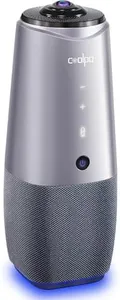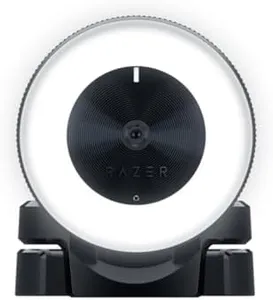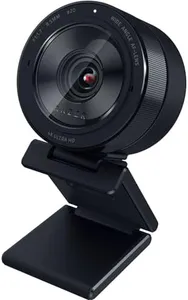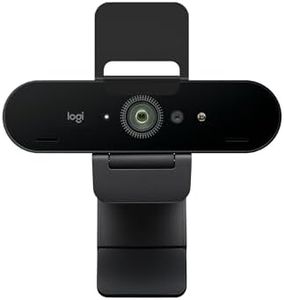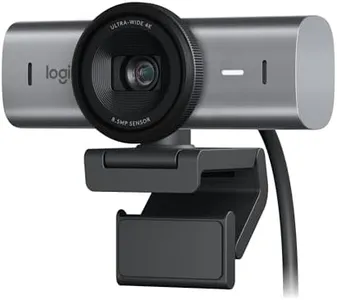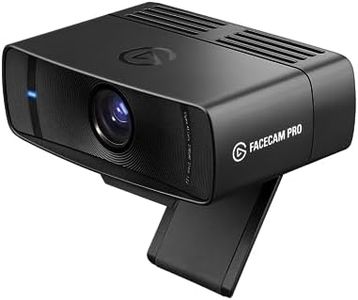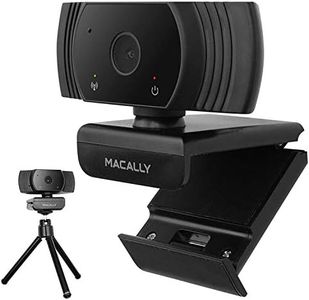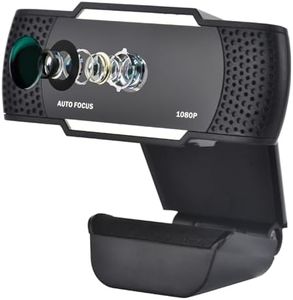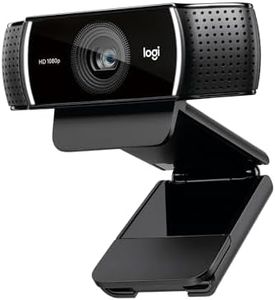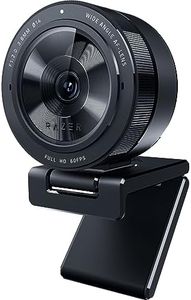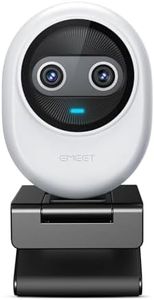10 Best Usb Webcams 2025 in the United States
Our technology thoroughly searches through the online shopping world, reviewing hundreds of sites. We then process and analyze this information, updating in real-time to bring you the latest top-rated products. This way, you always get the best and most current options available.

Our Top Picks
Winner
Razer Kiyo 1080p 30 FPS/720 p 60 FPS Streaming Webcam with Adjustable Brightness Ring Light, Built-in Microphone and Advanced Autofocus
Most important from
6127 reviews
The Razer Kiyo Streaming Webcam offers a resolution of 1080p at 30 FPS or 720p at 60 FPS, making it suitable for high-quality streaming. It features an adjustable brightness ring light that helps maintain even and flattering lighting, which is beneficial for low light performance and eliminating harsh shadows. The advanced autofocus ensures that footage remains sharp and clear without manual adjustments.
The frame rate drops to 30 FPS at the higher 1080p resolution, which might be a limitation for those who prioritize smoother video quality over higher resolution. The built-in microphone provides convenience but may not match the quality of dedicated external microphones. The webcam is compatible with popular streaming platforms like OBS and Xsplit, making it versatile for various use cases.
Its compact size and easy portability are added advantages for travelers or those attending gaming conventions. The mounting options are straightforward but might lack the flexibility of more advanced mounting systems. Additionally, despite its compact design, the field of view (FOV) isn't explicitly stated, which could be a concern for users needing a wider capture range. The Razer Kiyo is a strong contender for streamers and content creators who value good lighting and sharp autofocus, though some may need to supplement it with an external microphone for the best audio quality.
Most important from
6127 reviews
Razer Kiyo Pro Ultra 4K Webcam: Large Sensor - Auto Light Correction - Built-in Mic and Shutter - Pro Grade Content Creation, Streaming, Gaming, Video Calls - Works with OBS, Xsplit, PC, Zoom, Teams
Most important from
198 reviews
The Razer Kiyo Pro Ultra 4K webcam stands out with its impressive 4K resolution and a large 1/1.2" Sony STARVIS 2 sensor, which captures sharp, detailed images and accurate colors, making it ideal for professional content creation and streaming. Its custom F/1.7 aperture lens lets in a lot of light, ensuring clear videos even in dimly lit rooms, which is beneficial if you often work or stream in varying lighting conditions. The webcam also features AI-powered autofocus and auto exposure, keeping your face sharply in focus and well-lit without manual adjustments. One notable feature is its ability to blur the background naturally, giving your video a polished, portrait-like look without needing extra software.
The webcam supports HDR at 30 FPS, enhancing color and contrast for a more vibrant image. You can stream in uncompressed 4K at 24 FPS, 1440p at 30 FPS, or 1080p at 60 FPS, offering flexibility depending on your streaming setup or internet speed. It includes a built-in microphone and a physical shutter for privacy, though while the microphone quality is generally good, it may not replace a dedicated external mic for clear audio needs. Mounting options are typical for webcams, fitting most monitors or tripods.
The device is optimized for Windows with full software controls to fine-tune settings; however, on MacOS, advanced features are limited to plug-and-play basic use. Key considerations include a slightly heavier build and the fact that some advanced features aren’t available on Mac. Additionally, streaming at full 4K resolution requires a powerful computer and good internet speed. This webcam is well suited for serious streamers, content creators, and professionals who want high-quality video with flexible controls in both good and poor lighting environments.
Most important from
198 reviews
Logitech Brio 4K Webcam, Video Calling, Noise-Cancelling mic, HD Auto Light Correction, Wide Field of View, Works with Microsoft Teams, Zoom, Google Voice, Google Meet, PC/Mac/Laptop/MacBook/Tablet
Most important from
1049 reviews
The Logitech Brio 4K Webcam is a top-tier choice for anyone needing high-quality video and audio for video calls or streaming. It supports ultra HD 4K resolution at 30 frames per second, which means your video will be very sharp and smooth. The webcam features autofocus and a 5x digital zoom, so you can keep the focus clear even when moving or zooming in. You can select from three different field of view options (65°, 78°, and 90°) to frame yourself and your background just right, which is handy if you want to show more of your environment or focus tightly on your face. Its RightLight 3 technology automatically adjusts lighting, helping you look good even in challenging lighting conditions like backlit or dim rooms.
The dual microphones with noise-canceling technology deliver clear sound while reducing background noise, which should improve how you sound on calls. It comes with a privacy shutter for those moments when you want to physically block the camera, adding a layer of security. The webcam also supports Windows Hello facial recognition for fast and secure login on compatible Windows devices. It connects via USB-A or USB-C and works well across Windows, Mac, and ChromeOS, plus popular apps like Microsoft Teams, Zoom, and Google Meet.
While the 5x digital zoom is useful, it’s not the same quality as optical zoom, so image detail may drop when zoomed in. Also, 4K video at 30 fps is excellent, but some streaming or video conferencing platforms might not fully support 4K, meaning you may often use lower resolutions. If you want a highly flexible, professional-quality webcam that performs well in different lighting and sound environments, the Logitech Brio is a strong pick, especially for remote work or content creation.
Most important from
1049 reviews
Buying Guide for the Best Usb Webcams
When choosing a USB webcam, it's important to consider your specific needs and how you plan to use the webcam. Whether it's for video conferencing, streaming, or casual video calls, different webcams offer various features that can enhance your experience. Understanding the key specifications will help you make an informed decision and select the best webcam for your requirements.FAQ
Most Popular Categories Right Now
